

| Cryptocephalus coryli at Sherwood Forest NNR | ||
| In 2008, we rediscovered
the RDB1 and UKBAP priority beetle Cryptocephalus
coryli at a single location within the Sherwood
Forest NNR, which was until recently, believed to be the
only site in the UK where this beetle still occurs. Since then, we have continuously surveyed for the beetle at Sherwood from April to July each year, in order to monitor the population and detail any findings. All known records of this beetle recorded from Sherwood Forest, can be found by clicking the link to a seperate page below. 2011 and 2012 proved to be good years for Cryptocephalus coryli, known more commonly as the Hazel Pot Beetle and by utilising the unique surveying methods developed for this beetle by ourselves, we subsequently made several important discoveries regarding the habits of this critically endangered beetle. |
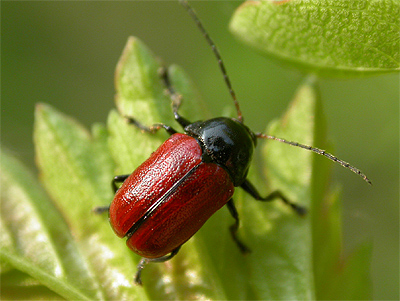 |
|
| ..... |
| Life
history of Cryptocephalus coryli
and other Cryptocephalus
species The life cycle of Cryptocephalus beetles is an interesting one. Once mated, the female begins to lay, holding each egg laid between her rear tarsi, turning it and covering it with dung at the same time. Once the egg is completely coated, the female drops the 'pot' to the ground. When the egg hatches, the young larva makes a hole at one end, through which it can emerge to feed and move about in the leaf litter. As the larva grows, it enlarges the pot which eventually attains a length of about 14mm. In the wild, larval development usually takes two years, but larvae are often full grown within a year when kept in captivity. Once mature, the larva seals the end of the pot, turns around inside to face the other way and pupates. When the beetle emerges, it cuts itself out of the pot and climbs the nearest vegetation before flying. |
|||
| ....................... | |||
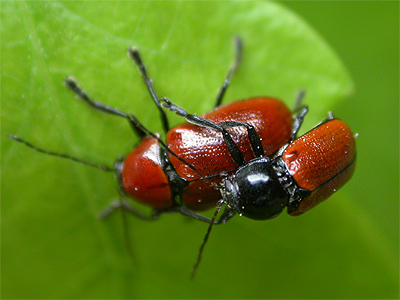 |
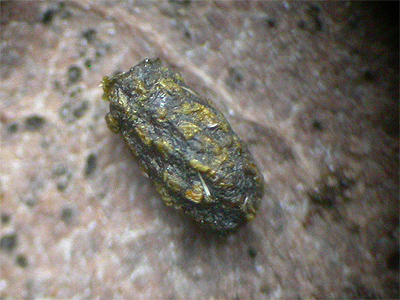 |
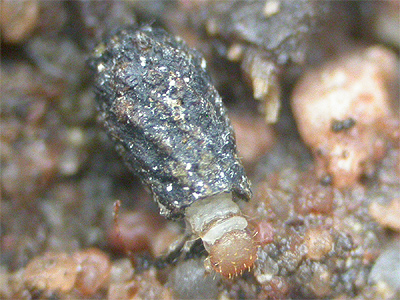 |
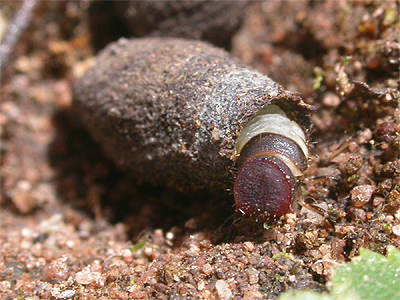 |
| ....................... | |||
| Cryptocephalus
coryli and the
latest news on its present UK status At this point, it may be best if we provide an update on the current status of Cryptocephalus coryli in the UK. In recent years, it was believed that the Sherwood Forest colony was the only one left in the UK and since 1970, it had only been found at three single sites - in Berkshire, Lincolnshire and Surrey (Ref: Natural England) and was believed to be extinct from all other known sites. No recent records were forthcoming following enquiries by several authors of recent reports on the beetle. In July 2013, Allan and Annette Binding reported that Allan recorded a single male Cryptocephalus coryli at a heathland site in Clumber Park earlier in July. This is obviously a new Nottinghamshire site for the beetle, so is welcome news indeed. Allan and Annette also reported that two females had also been found at Whisby in Lincolnshire by Richard Davidson. Whisby was the location of a release scheme a number of years ago and it was thought that the beetle had died out there until Richard' discovery. We know that it is currently doing well at Sherwood Forest, but it is strongly believed that C. coryli is still present at Box Hill and Headley Warren in Surrey (per Denton, J. and Collins, G.) but no one has purposely looked for it in the last few years. There have also been no records from Woolmer Forest in Hampshire, since it was recorded there for the first time in 2002 (Lawn, M.) despite further searching and there have been no records from any Lincolnshire site other than Whisby since 2007 (per Barnes, C.) Historical records of Cryptocephalus coryli in Nottinghamshire Many years ago, Cryptocephalus coryli was a widespread species across the southern counties of England, but it declined greatly during the last century to become one of the UK's rarest insects. It's decline is thought to have coincided with the reduction in coppicing. In the south of the UK, it occurred on hazel growing along woodland edges, rides and hedgerows, but in the north preferred a heathland habitat with Birch scrub or young trees. Historically, Sherwood Forest was always regarded as being good for C. coryli by collectors in the early 1900's, when over a dozen adults could be taken on each visit to this locality, with the beetles either being beaten or picked from young Birch and Oak during June. |
||
| ..... |
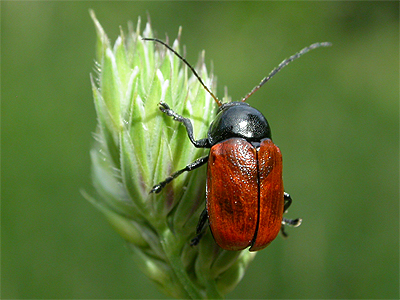 |
Some Sherwood Forest
records dating back to the 1930's, remained something of
a mystery until early in 2011, when work to re-organise
the coleoptera collection at Leicestershire Museum CRC at
Barrow-upon Soar, finally helped clear up some of the
confusion regarding records dating back to around this
time. The re-organisation also provided additional records dating from 1929, 1939 and 1940, which seemed to have been previously unknown or were lost from the record books. These are listed in the table of all Sherwood's C. coryli records at the bottom of this page. Although most of these records still list no recorder or determiner, it is hoped that we can make further enquiries to complete the relevant information over the next few months. In May 28th 2008, we found an attractive red beetle resting on a dead Rosebay Willowherb stem in an area of the Sherwood Forest Country Park. It's identity as a female Cryptocephalus coryli, was determined from photographs took on site, on our return home. |
|
| ..... | ||
| Being amazed
at the potential of the find and after reading about the
reintroduction scheme that had taken place in
Lincolnshire in 2000, we made further enquiries to
ascertain whether a similar introduction had occurred in
Nottinghamshire, and in particular at Sherwood Forest. It
turned out that no such introduction scheme had taken
place and that this record was the first in
Nottinghamshire for at least 70 years. Two more records
of females followed on May 29th and June 4th. The area was surveyed on behalf of Natural England East Midlands by Allan and Annette Binding in 2009, whilst we continued our own searches for the beetle. Both the Bindings and ourselves, also conducted unproductive surveys at other potentially suitable locations within the Country Park area. We surveyed the area again in 2010 on behalf of Nottinghamshire County Council and in conjunction with our own survey work, finding only two adults, despite what seemed very favourable weather conditions. |
||
| ..... | ||
| In Autumn 2009, we were
consulted about the potential affects thinning work (as
part of the sites on-going management plan) in the two
main compartments bordering and containing C. coryli
would have. In the end it was decided that work
in one compartment would be postponed to a later date,
with work being carried out in the other during early
March 2010. Thinning work and the removal of timber was carried out as per our recommendations and damage to habitat by machinery was minimal at most. Birch and Hawthorn scrub known to be used by C. coryli females was left untouched. Trees in the remaining compartment not touched in March 2010, were later thinned in January 2011. We were personally involved with the work, selecting and marking the trees to be felled. The whole operation went very well, with an increase in potentially suitable areas of habitat being created and opened up, but with just two adults recorded in 2010, it was always difficult to know if the beetle was in decline or it had just been a bad year. In the end, 2011 turned out to be a remarkable year with a total of 71 adults recorded. |
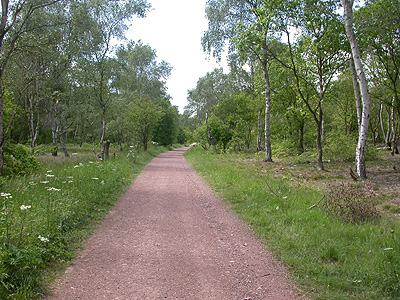 |
|
| ..... | ||
| Some
new observations on the habits of Cryptocephalus
coryli made during 2011 Continued study and survey of the site during 2011 saw us greatly increase our personal understanding of the habits of C. coryli and several important new discoveries were made, which would certainly go some way towards explaining why coryli went 'missing' at Sherwood Forest (and probably other sites in the UK) for decades without being found. Two adults observed on small scrub Oak and Birch and then seen flying directly to the top of nearby mature Birches, provided us with our first indication that we may have spent many hours looking in the wrong place (although still proving successful) and that maybe we were not looking high enough. We were able to confirm this during May and early June by advancing our survey techniques, conducting several surveys of the larger trees from the ground using binoculars and a telescope, all of which produced double figure counts during peak season. It was a slow and painstaking method involving several scans of each tree, but proved extremely successful on windless days. Finding that adults generally preferred taller trees, could be a likely explanation for the poor numbers recorded in 2010. |
||
| ..... | ||
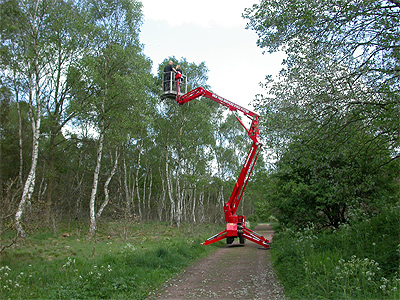 |
It was found that
branches of thicker foliage, with a sunny aspect and
around 30 feet above ground level were particularly
favoured. No adults were found at the very top of the
largest Birches in the area we surveyed using a cherry
picker to a height of 50 feet, but it was obvious that
the foliage quality on larger Birches was of noticeably
poor quality. During windy weather, adult coryli adopt a policy of moving from the leaves and wrapping their legs around thin stems until conditions have settled. Even when on small scrub, adults are actually quite difficult to find when doing this. We were hampered by very breezy conditions on the day of the survey, but still recorded 13 adults which would not have been visible from the ground surveying with binoculars and telescope. Over the years, the available literature has suggested that C. coryli uses 'key' trees, typically Birch scrub and young trees and whilst females are often found on Birches fitting that criteria, the number of adults found on these must be a fraction of the actual population. |
|
| ..... | ||
| We now think
that perhaps too much emphasis has been placed on the use
of 'key' trees in the past. But if these trees are
necessary for coryli, then 'key' groups of
mature Birches are more likely, where the microclimatic
conditions for the beetle are optimal and the foliage is
healthy. Evidence for this comes from recording loose
groups of adults within close proximity on single or
adjoining trees, though we have recorded three adults on
a single leaf. Our reasoning for this stems from the fact that key trees have always been habitually small and much easier to check for coryli than much larger (30-50 feet high) trees. We believe that this has led to the misconception that key trees are used by successive generations of females. We are inclined to think that after spending many hours checking several key trees at Sherwood CP, we would have expected to have noted males flying around them or sat on them in their search for females. Several 'key' trees used in 2008 and 2009 have not been used since and it is most likely that many adults found on small scrub, have just simply climbed there after emergence, as they do grass and other vegetation before their first flight. |
||
| ............... |
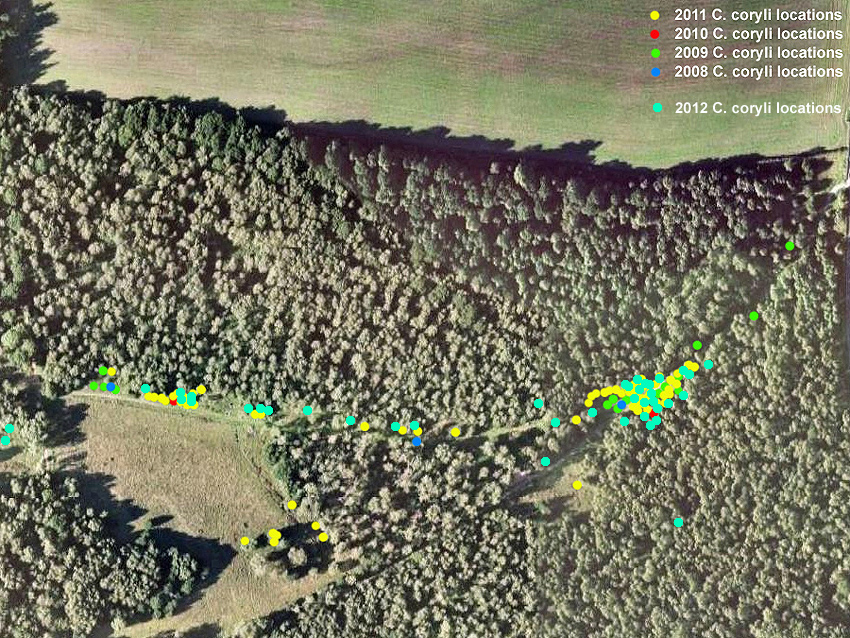 |
||
| ............... | ||
| Although
males are more active than females near the tops of
Birches, we noted that they spend much time sunning
themselves on warm afternoons. Greatest male flight
activity seems to occur between 09:00h and 12:00h on fine
warm days. We have never recorded males on scrub Birches
and have found no evidence yet to suggest that females
descend from height deliberately seeking out scrub (key?)
Birch. We also recorded a female on Downy Birch (Betula
pubescens) for the first time in 2011. Plotting the locations of all adult coryli found at Sherwood Forest since 2008 on the map above, certainly shows that although this beetle is fussy about its habitat requirements, having the correct habitat for larval development is even more important. The lack of habitat which combines the two required elements for both adult and larval stages, helps explain why coryli remains restricted at Sherwood Forest CP. Slightly damper soil containing a mixture of coarser grasses, Rosebay Willowherb and (to a lesser extent) Umbellifers, seems to be a key factor in larval development at Sherwood. Areas of finer grasses such as Fescues on drier soils are less suitable unless the grass is left untouched. |